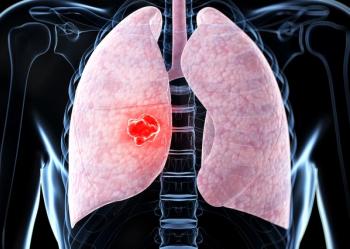
Favorable Detection Rates Reported With 18F-rhPSMA-7.3 for Recurrence of Prostate Cancer
Data reported from the phase 3 SPOTLIGHT trial of the novel theranostic 18F-rhPSMA-7.3 at 2022 ASCO GU show “excellent image quality” for prostate cancer recurrence detection, according to expert.
At the
“There’s excellent image quality,” said coordination investigator David M. Schuster, MD, FACR, Emory University School of Medicine, “and also the potential for low urinary secretion, which, as we know, is important for imaging prostate cancer.”
In particular, 18F-rhPSMA-7.3, an investigational prostate‐specific membrane antigen (PSMA)‐targeted radiohybrid (rh) PET imaging agent, demonstrated an overall evaluable detection rate (DR) in this study population of 83% by majority read.
“Up to 40% of patients who undergo radical prostatectomy, and up to 50% of patients who undergo radiation therapy will develop local or distant recurrences within 10 years, and the ability to determine the extent and location of recurrent prostate cancer to inform appropriate clinical management for these men is key for physicians and their patients,” Schuster, said in a press release issued by Blue Earth Diagnostics.2 “Conventional imaging techniques have many limitations in prostate cancer identification and localization, and greater imaging accuracy is needed throughout the care continuum, to optimize therapeutic decision‐making.”
Therefore, researchers aimed to evaluate 18F‐rhPSMA‐7.3 PET imaging as a potential decision‐making aid to determine suspected biochemical recurrence of prostate cancer across a wide PSA range.
In the prospective, multicenter, single‐arm imaging study, conducted in the United States and Europe, 389 men (median PSA, 1.10 ng/mL [range, 0.03-134.6]) were enrolled. To meet the inclusion criteria, patients had to be male, over the age of 18, have a history of localized prostate cancer with prior curative intent treatment, have an elevated PSA suspicious of biochemical recurrence, and be potentially eligible for salvage therapy with curative intent.
Following an IV administration of 296 MBq 18F-rhPSMA-7.3, patients underwent PET for 50 to 70 minutes. At 60 days post-PET, investigators performed image-guided biopsies of PET lesions. At 90 days post-PET, investigators performed any confirmatory imaging. Scans were evaluated by 3 blinded central readers, with a final consensus of “majority read”. Each patient also underwent a separate Standard of Truth (SoT) via Truth Panel.
The coprimary endpoints were patient level CDR, or percentage of patients scanned with 1 true positive lesion, and region level positive predictive value (PPV), which was determined for all PET positive regions combined using histopathology and/or conventional imaging as a composite SoT. Analysis of these metrics were also performed in a group of patients with a histopathology-only SoT.
A strict imputation method was implemented in both primary end points, in which PET-positive lesions that were proven on conventional imaging were considered false positive, and the prespecified statistical threshold for CDR and PPV were set to 36.5% and 62.5%, respectively.
Results showed that the patient level CDR was 56.8% (95% CI, 51.6%-62.0%) in the 366 men (median PSA, 1.27 ng/mL [range, 0.03-134.6]) with a composite SoT. While this finding met the prespecified threshold, the region level PPV did not (59.7%; 95% CI, 54.7%-64.7%]).
However, Schuster said, “Keep in mind [that] the data from this cohort with a composite Standard of Truth are limited by the high proportion of scans, especially those of the prostate [and] bed that relied on conventional imaging, which is a suboptimal Standard of Truth in itself.”
Furthermore, investigators found that the patient level CDR was 81.2% (95% CI, 69.9%-89.9%) and the region level PPV was 71.6% for the subset of patients with a histopathology-only SoT. Both percentages would have met their prespecified thresholds.
There were no serious adverse events (AEs) related to 18F-rhPSMA-7.3. The most frequently reported AEs were hypertension (1.8%; n = 7), diarrhea (1.0%; n = 4), injection site reaction (0.5%; n = 2), and headache (0.5%; n = 2). In total, 4.1% of patients (n = 16) had at least 1 AE that could possibly be related to the novel theranostic.
In his concluding remarks, Schuster said, “Together, these data support the clinical utility of 18F-rhPSMA-7.3 PET in men with recurrent prostate cancer across a wide PSA range.”
References
- Schuster DM. Detection Rates of 18F-rhPSMA-7.3 PET in Patients with Suspected Prostate Cancer Recurrence: Results from a Phase 3, Prospective, Multicenter Study (SPOTLIGHT). Paper presented at: 2022 ASCO Genitourinary Cancers Symposium; February 17-19, 2022; San Francisco, California. Abstract #9.
- Blue Earth Diagnostics Press Release. Blue Earth Diagnostics Announces Key Results from Phase 3 SPOTLIGHT Study of 18F‐rhPSMA‐7.3, an Investigational PET Imaging Agent, in Biochemical Recurrence of Prostate Cancer. Published February 15, 2022. Accessed February 18, 2022. https://bit.ly/3BtMJap.
Newsletter
Stay up to date on recent advances in the multidisciplinary approach to cancer.

















































































